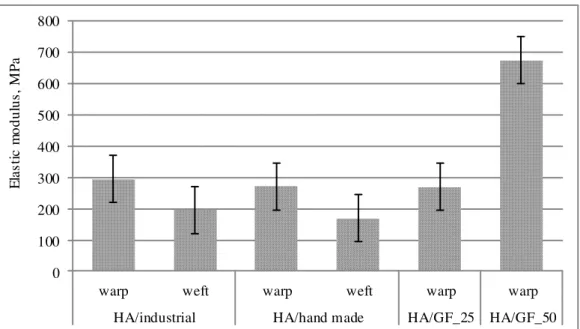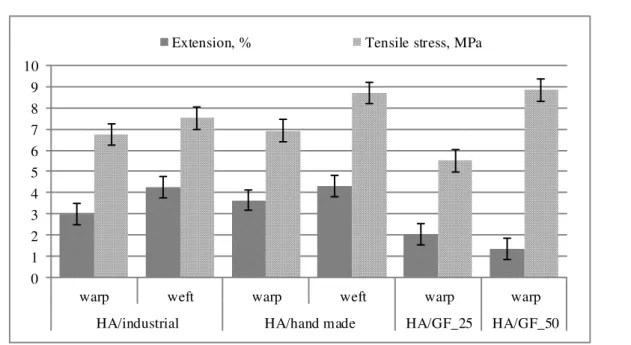Study of Performance of Hybrid yarns (Hemp/ Polypropylene/
Glass) Woven Reinforcements
Maris Manins *, Aina Bernava**, Guntis Strazds ***
*(Forest Industry Competence Centre, Dzerbenes Street 27, LV-1006, Riga, Latvia ) ** (Forest Industry Competence Centre, Dzerbenes Street 27, LV-1006, Riga, Latvia) *** (Forest Industry Competence Centre, Dzerbenes Street 27, LV-1006, Riga, Latvia)
ABSTRACT
This study examines the performance of reinforcements of 100 tex hemp yarns and hybrid yarns reinforcements with same hemp yarns and glass fibres’ (136 Tex) in warp direction (25 % or 50 %) interwoven
with hemp yarns. The industrial loom CTБ-175 and craftsman’s loom, plain weaving technique for production of reinforcements with surface density in range of 91-246 g/m2 were used in the production. Tensile strength of hemp reinforcement on warp direction is 241.7N-279.8N and tensile modulus 218.48MPa-271.24MPa.The measurement of fabric thickness and physical-mechanical properties of reinforcements were carried out according to ISO 5084:1996 and LVS EN ISO 13934-1-2001 standards. One and two layer composites of woven reinforcements of hemp and polypropylene yarns were produced with Laboratory Press LP_S_50/SASTM. The surface density of one layer composite is 311.2 g/m2 and 608.4 g/m2 of two layers composite. The tensile strength of same composites is 303.1N and 599.5N, the tensile stress is 35.66 MPa and 40.65 MPa. The elastic modulus of one layer composites is 908.2 MPa and 1152.5MPa for two layers composite. The mechanical properties of composites were established according to ISO 527-5:2009 standard.
Keywords
–
hemp yarn, glass fibers, polypropylene yarns, woven reinforcement, compositesI. INTRODUCTION
With increased strain on petroleum resources textiles are replacing traditional materials in various industries. Textile fibers and fabrics are increasingly being used to create fiber-reinforced plastic composites that have the fabric structure and surface density suitable for the future use of the particular composite and in which fiber materials are compatible with the matrix. Woven composites are superior to conventional materials due to their stiffness, strength, stability, weight, cost, manufacturing, corrosion resistance, insulation purposes, taking shape, etc. [1, 2, and 3]. The main factors evaluates, when deciding whether to use a textile composite or a conventional tape laminate are mechanical properties and the ease and cost of manufacture [4, 5]. Textile-reinforced thermoplastic composites have huge application potential in design and rapid manufacturing of lightweight structures with versatile possibilities of integrating functions. In structural applications, textile composites are usually used as reinforcement due to the possibility to tailor the load bearing capacity through the fiber architecture. As a result of their growing potential for lightweight applications, textile-reinforced thermoplastic composites are becoming of greater interest for the industry. Thermoplastic composites show a number of advantages compared to classical composites based on thermoset matrices, among
which the possibility of low-cost, rapid production has to be mentioned first [6, 7]. Between 10% and 15% of the total European Union (EU) composite market is covered by Wood-Plastic Composites (WPC) and Natural Fiber Composites (NFC) and the total volume of composites production was 352,000 tons in 2012 (260,000 t of WPC plus 92,000 t of NFC). Including 150,000 t of different wood and natural fibers was used in the composites for passenger cars and lorries in 2012 (90,000 t of NFC and 60,000 t of WPC). Using the newest technology, it is now possible to get area weight down to 1,500 g/m2 (with thermoplastics) or even 1,000 g/m2 (with thermosets), which are outstanding properties when compared to pure plastics or glass fiber composite. The forecast 600,000 t of bio composites, using 150,000 t of wood and natural fibers each along with some recycled cotton is intended to EU to 2020 [8].
The aim of the research is the comparing of mechanical properties of hemp yarns reinforcements
manufactured on the industrial loom CTБ-175 and
craftsman’s loom, and to determine the impact of glass fibers’ roving adding in the warp direction (25
% or 50%) of hemp yarn reinforcement. The another one task is to look for a rapid manufacturing method of hemp yarns and polypropylene yarns reinforcements with versatile possibilities for
integrating functions for one and two layers composites production.
II.
MATERIALS
AND METHODS OF PRODUCTION2.1. Materials
The hemp yarns (100 Tex), glass fibers (136 Tex) and polypropylene yarns (100 Tex) produced in EU were used for production of woven reinforcements. The physical-mechanical properties (Table 1) of yarns were tested before weaving according to the standard LVS EN ISO 5079:2001
Table1. Table 1 Physical and Mechanical Properties of Yarns Used
Hemp Glass fibers
Polypropy lene Designation HA GF PP
Yarn density
(Tex)
100 136 100
Relative tensile strength (N/Tex)
0.15 0.72 -
Relative extension
(%)
0.035 0.006 -
2.2. Method of production.
The industrial loom CTБ-175 [SU], craftsman’s loom and plain weaving technique were used for production of sample of 100 tax hemp yarn. The
craftsman’s loom and plain weaving technique were
used for production of hybrid yarns: hemp yarns and glass fibres yarns as well as hemp yarns and polypropylene yarns reinforcements (Figure 1A, 1B).
A
C
Fig.1. Reinforcements of hemp yarns (A), of hybrid yarns (B), composite (C). The size of samples is 2.5x 3.0 cm
2.3. Method of testing
To determine fabric thickness measurements were carried out using the thickness meter ATLASS according to the standard ISO 5084:1996 and surface density was calculated, according to the standard method LVS EN 12127:2001. The maximum force and elongation at maximum force of reinforcements on INSTRON dynamometer, corresponding to LVS EN ISO 13934-1-2001 standard were determined.
2.4. Production of composite
The reinforcements with surface density of 246 g/m2 and thickness of 0.83 mm with hemp yarns and PP yarns (the proportion of yarns 1: 2 on both directions) were used for composites production. The composites were formed by hydraulic press (Laboratory Press LP_S_50/SASTM) at 190°C temperature, preheating time 10 sec, contact + cooling time 6 min. The first composite (C_I) of one layer of reinforcement and the second composite (C_II) from two layers of reinforcement, described before, were produced (Figure1C).
2.5. Testing of composite
The test on mechanical properties has been carried out for warp direction, according to ASTM 0-3479 standard for polymer matrix composites, using an INSTRON dynamometer.
III.
R
ESULTS AND DISCUSSIONTable 2 Surface Parameters and Mechanical Properties of Reinforcements
Parameters HA_I industrial HA_H hand made HA/GF_25 HA/GF_50
Fabric thickness, mm 0.61 0.69 0.94 1.10
Surface density,g/m2 91 100 135 246
Thread direction Warp Weft Warp Weft Warp Warp
Relative tensile strength 3.07 2.74 2.42 3.03 1.91 1.98 Extension, % 2.99 4.27 3.64 4.32 2.02 1.31 Tensile stress, MPa 6.75 7.52 6.93 8.71 5.50 8.85 Elastic modulus, MPa 294.34 196.11 271.24 169.30 270.00 674.48
Ranges of average fabric thickness of hemp
yarn’s reinforcements are 0.61mm and 0.69 mm and 0.94mm and 1.1mm for hemp yarns /glass fiber reinforcements. The surface density of samples of hemp yarns is 91 g/m2 and 100 g/m2. For hybrid structure the surface density is 135 g/m2 for reinforcement with 25% of glass fiber yarns on warp direction and 246 g/m2 for reinforcement with 50%
of glass fibre’s yarns on warp direction (Table 2).
For industrially produced hemp reinforcement relative tensile strength (Table2) on warp direction is 1.2 times higher as handmade reinforcement, while on weft direction is higher for handmade reinforcement (1.2 times), due to impact of weaving process (Figure 2). The increase of relative tensile strength not achieved with incorporation on warp direction the glass fibers fraction.
0 100 200 300 400 500 600 700 800
warp weft warp weft warp warp
HA/industrial HA/hand made HA/GF_25 HA/GF_50
E
la
s
ti
c
m
o
d
u
lu
s
,
M
P
a
Fig. 2 Reinforcements elastic modulus, MPa
The elastic modulus (Fig.2) is 2.3 times higher with incorporation on warp direction glass fiber (50%) as for industrial made hemp yarns reinforcement.
The problem for woven reinforcements of natural fibers is high extension. With incorporation 25% or 50% of glass fibers on warp direction, the extension is reduced
0 1 2 3 4 5 6 7 8 9 10
warp weft warp weft warp warp
HA/industrial HA/hand made HA/GF_25 HA/GF_50 Extension, % Tensile stress, MPa
Fig.3 Reinforcements extension, % and tensile stress, MPa
Table 3 Composites Surface Parameters and Physical - Mechanical Properties
Designation
Composite thickness, mm
Surface density, g/m2
Tensile strength, N
Tensile extension, %
Tensile stress, MPa
Elastic modulus, MPa
C_I 0.34 311 303.1 0.61 35.7 908.2
C_II 0.59 608 599.5 0.55 40.7 1152.5
A one layer composite thickness is 0.34mm and density 311 g/m2 (Fig. 1c, Table 3), same parameters of two layers composite is 0.59 mm and 608 g/m2. For two layers composite the increase of tensile strength was 1.9 times, tensile stress - 1.1 times and elastic modulus 1.3 times compared to the one layer composite. While decrease of tensile extension 3.7- 2.4 times was achieved for composites compared to reinforcements of hemp yarns with glass fiber yarns adding
.
IV.
CONCLUSION
The technical textile based composites are the rapidly developing within engineering light-weight materials. The hemp yarns and glass fibers on the warp direction (25 % or 50%) were used for reinforcement production.
Investigation of woven fabric structures from natural hemp yarns show a strong impact of weaving process on mechanical properties – relative tensile strength,
warp direction (3%) as for industrial made reinforcement. The tensile modulus on warp direction is higher for 20% for handmade reinforcement but on weft direction for industrial made reinforcement about 14%. Incorporation of glass fibers in warp system could substantially increase the mechanical properties of fabric in warp direction.
The tensile extension on both directions is slightly lower (2%- 4%) for industrial made reinforcement. Reduce of extension on warp direction 1.4- 1.8 times was achieved by incorporating glass fibers (25 %) and 2.3-2.7 times by incorporating glass fibers (50 %) in warp direction.
Acknowledgements
The authors would like to thank the Director of Riga Technical University Institute of Polymer Materials Dr. J. Zicans and the staff for their support in the development of the composites.
REFERENCES
[1] A. Bernava, M.Manins, S. Kukle, Natural Fibers Woven Structures for Composites Reinforcements, Journal of Biobased Materials and Bioenergy, 6, 4, 2012, 449-455. [2] A. Bernava, M. Manins, S. Kukle, Mash Type
Woven Structures for Composites Reinforcements, Proc.12th Autex World Textiles Conference, Innovative Textile for High Future Demands: Croatia, Zadar, 2012, 1623-1628.
[3] M. Manins, S. Kukle, G. Strazds, A. Bernava, Renewable Resource Integration in Biodegradable Composites, Proc. 8th International Scientific and Practical Conference. Environment. Technology. Resources.2, 2011, 139-144.
[4] W. Hufenbach, A. Langkamp., F. Adam., M. Krahl, A. Hornig, M. Zscheyge, K. Modler H., An integral design and manufacturing concept for crash resistant textile and long-fibre reinforced polypropylene structural components; Procedia Engineering, 10, 2011, 2086-2091.
[5] W.Hufenbach, A. Langkamp, M. Gude, C. Ebert, A. Hornig, S. Nitschke, H. Böhm Characterisation of strain rate dependent material properties of textile reinforced thermoplastics for crash and impact analysis.
Procedia Materials Science 2, 2013. 204 – 211.
[6] G. Nam, N. Wu, K. Okubo, T. Fujii, Effect of Natural Fiber Reinforced Polypropylene Composite Using Resin Impregnation,
Agricultural Sciences, 5, 2014, 1338-1343. [7] S. Parveen, S. Rana, R. Fangueiro., Natural
Fibre Composites for Structural Applications,
Post conference book Mechanics of Nano, Micro and Macro Composite Structures, Torino, Italy, 2012, 1-2

